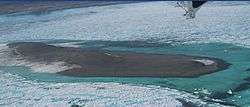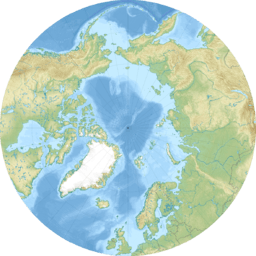Kaffeklubben Island
Kaffeklubben Island or Coffee Club Island (Danish: Kaffeklubben Ø; Greenlandic: Inuit Qeqertaat) is an island lying off the northern tip of Greenland. It contains the northernmost point of land on Earth.
| Native name: Oodaap Qeqertaa | |
|---|---|
 Aerial photo of Kaffeklubben Island taken on 29 September 2008 | |
 Kaffeklubben Island | |
| Geography | |
| Location | Arctic Ocean |
| Coordinates | 83°39′45″N 30°36′50″W |
| Administration | |
| Northeast Greenland National Park | |
| Demographics | |
| Population | Uninhabited |
Discovery
The first recorded sighting of the island was made by the United States explorer Robert Peary in 1900; however, Kaffeklubben was not visited until 1921. When the Danish explorer Lauge Koch set foot on the island, it received its name, after the coffee club in the University of Copenhagen Geological Museum.
In 1969, a Canadian team calculated that its northernmost tip is 750 metres (2,460 ft) farther north than Cape Morris Jesup, thus claiming its record as the most northerly point on land.
Since then, several gravel banks have been found to the north, such as Oodaaq, 83-42, and ATOW1996, although there is debate as to whether such gravel banks should be considered for the record since they are rarely permanent, being regularly swallowed by the moving ice sheets, shifting, or becoming submerged in the ocean.
Geography

Kaffeklubben Island is 713.5 kilometres (443.3 mi) from the geographic North Pole. The island lies off Cape James Hill, 10 kilometres (6.2 mi) northwest of Bliss Bay,[1] about 37 kilometres (23 mi) east of Cape Morris Jesup, a little east of a central point along the northern coast of Greenland. It is approximately 0.7 kilometres (0.43 mi) long,[2] and about 300 metres (980 ft) across at its widest point. The highest point is about 30 metres (98 ft) above sea level.[2]
Vegetation
Despite the harsh environment, vegetation grows on Kaffeklubben island, including various mosses, liverworts, and lichens, and also flowering plants: Saxifraga oppositifolia (purple saxifrage) and Papaver radicatum (arctic poppy).[3][4][5][6]
See also
- List of islands of Greenland
- ATOW1996, also claimed as the most northerly land area.
- 83-42, another potentially northernmost point of land
- List of northernmost items
References
- "Oodaap Qeqertaa". Mapcarta. Retrieved 13 June 2019.
- Funder, S. V. E. N. D.; Larsen, O. (Nov 15, 1982). "Implications of volcanic erratics in Quaternary deposits of North Greenland" (PDF). Bulletin of the Geological Society of Denmark. 31: 57–61. ISSN 0011-6297. Retrieved August 23, 2014.
- Arctic Thule. "Kaffeklubben – Top of the World?". Retrieved 25 October 2013.
- http://www.atlasobscura.com/places/the-flowers-of-kaffeklubben-island
- "Archived copy". Archived from the original on 2014-08-26. Retrieved 2014-08-23.CS1 maint: archived copy as title (link)
- "Archived copy". Archived from the original on 2013-10-29. Retrieved 2014-08-23.CS1 maint: archived copy as title (link)